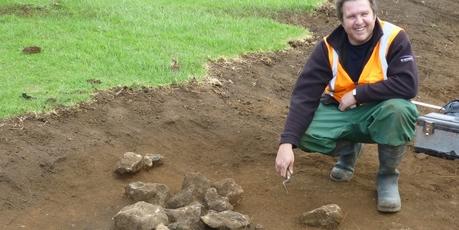Northland dig uncovers 800-year-old signs of living
Joseph Aldridge
Source - http://www.nzherald.co.nz/nz/news/article.cfm?c_id=1&objectid=10805250

Archaeologist Richard Shakles at the site of an ancient Maori fire pit uncovered during work on the Kamo bypass last year. Photo / Northern Advocate
Significant evidence of early Maori settlement in the Kamo area of Whangarei was discovered during work on a bypass last year.
Archaeologists found hangi pits, fire scoops, post holes and stone mounds, as well as charcoal believed to be almost 800 years old. Earthworks for the bypass were carried out under an archaeological Historic Places Trust authority.
Lead archaeologist Sarah Phear said radio-carbon dating techniques were used to place some of the features to around 1230-1275AD "with a high degree of certainty".
"We were surprised at how old the site was and also the fact that the site is so far away from the coast - which is quite rare for Northland."
Plant microfossil analysis indicated large scale clearance of forest using fire had taken place, Dr Phear said.
"A lack of starch in the samples indicated that the sample deposits hadn't been used for cultivation, or for cooking starchy crops like kumara and fern root.
"This suggested that clearance of the forest had taken place at an early stage of settlement before human land use had begun and that it was therefore reasonable to assume that it was an early site."
However, the question of whether the people who cleared the forest near Kamo were the first generation of Polynesians who settled in New Zealand remains unanswered.
"It's very difficult to say with certainty whether they were the first generation or not. It's fair to assume, though, that they would have been some of the earliest settlers in the area." Fresh water nearby may have attracted the settlers there, Dr Phear said.
"It may not be obvious today, but two late 19th-century plans indicate that there was a swamp in the area at that time next to the Otangarei Stream. Local traditional histories of the Ngaitai hapu also speak of a lake in the area of the present Kamo golf course."
She and her team hoped to investigate the site further to learn more about the historic landscape.
Te Parawhau representative Te Ihi Tito was excited to hear the news.
"It probably relates back to the initial clearing of the forest for gardening in Kamo," he said.